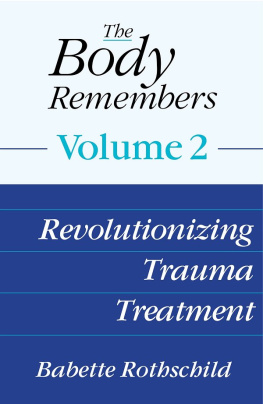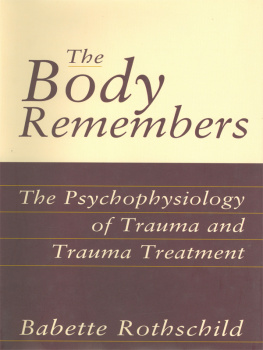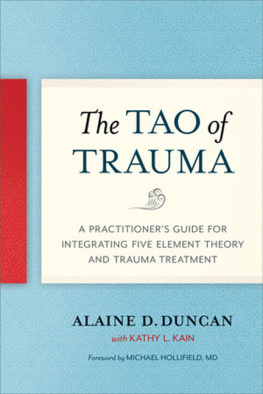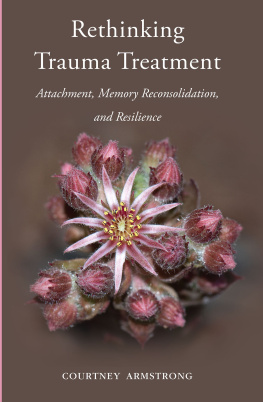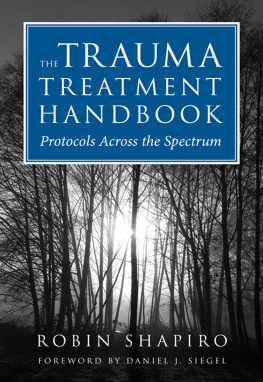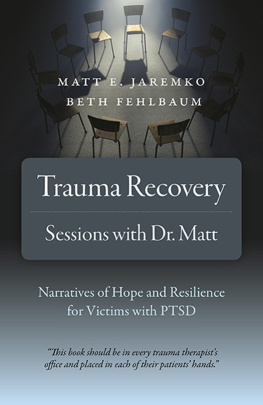Rothschild - Revolutionizing Trauma Treatment
Here you can read online Rothschild - Revolutionizing Trauma Treatment full text of the book (entire story) in english for free. Download pdf and epub, get meaning, cover and reviews about this ebook. year: 2017, publisher: W. W. Norton & Company, genre: Romance novel. Description of the work, (preface) as well as reviews are available. Best literature library LitArk.com created for fans of good reading and offers a wide selection of genres:
Romance novel
Science fiction
Adventure
Detective
Science
History
Home and family
Prose
Art
Politics
Computer
Non-fiction
Religion
Business
Children
Humor
Choose a favorite category and find really read worthwhile books. Enjoy immersion in the world of imagination, feel the emotions of the characters or learn something new for yourself, make an fascinating discovery.
- Book:Revolutionizing Trauma Treatment
- Author:
- Publisher:W. W. Norton & Company
- Genre:
- Year:2017
- Rating:3 / 5
- Favourites:Add to favourites
- Your mark:
- 60
- 1
- 2
- 3
- 4
- 5
Revolutionizing Trauma Treatment: summary, description and annotation
We offer to read an annotation, description, summary or preface (depends on what the author of the book "Revolutionizing Trauma Treatment" wrote himself). If you haven't found the necessary information about the book — write in the comments, we will try to find it.
Revolutionizing Trauma Treatment — read online for free the complete book (whole text) full work
Below is the text of the book, divided by pages. System saving the place of the last page read, allows you to conveniently read the book "Revolutionizing Trauma Treatment" online for free, without having to search again every time where you left off. Put a bookmark, and you can go to the page where you finished reading at any time.
Font size:
Interval:
Bookmark:
The Body
Remembers
Volume 2
Revolutionizing
Trauma Treatment
BABETTE ROTHSCHILD

W. W. Norton & Company
Independent Publishers Since 1923
New York London
A NORTON PROFESSIONAL BOOK
to, for, and from
Joe
with Love and Gratitude
I Am Free
Clare Jones
When the ghosts of my past whisper to me
I say, I am free
I open my eyes and I see
Pinks, blues, reds and orange
Yellow, purple, turquoise is my favourite
A world of rich tapestry
When the ghosts of my past shout loudly at me
I say NO firmly
I open my ears and I hear
Birds singing, engines purring, people talking, laughing
I look, I see
The ghosts are not here with me
Leaves falling, children playing, couple arguing, man smoking
When the ghosts feel too close to my skin
I feel
The ground beneath my feet
The breeze touching my face
The warmth of the sun
The fabic inside my pocket, against my hand
A touching embrace
The ghosts cannot compete
With the power of nature
I see
I hear
I feel
I taste
Delicious distractions
Like honey, smooth and sweet
Bitter chocolate, juicy orange, sugary treat
The ghosts are far away now
I am safe
I see my friends, my colleagues, my family
I am here, now
I am free
I know
The ghosts are ghosts
They are not here now
They cannot hurt me
I am free
T his book, The Body Remembers, Volume 2: Revolutionizing Trauma Treatment, continues the discussion I began in my first book, The Body Remembers: The Psychophysiology of Trauma and Trauma Treatment (Rothschild, 2000). As soon as that book went to press, I knew there was more that I wanted to contribute to the field of traumatic stress to continue to improve and expand treatment options for those impacted by trauma. The four books Ive published since have broadened the discussion, but I have always wanted to return to expanding on the foundations of the first. In this second volume I will do just that. That means that this is not a revision of The Body Remembers, but a stand-alone book in its own right that is linked to it. (You can make use of this book without having read the first volume.)
In the years since my first book was published, I have continued in my capacity as psychotherapist, body psychotherapist, and trauma therapist while practicing, teaching, lecturing, supervising, and consulting around the world. My professional programs have been attended by tens of thousands from all corners of the helping professions, representing every educational level, theoretical background, and available method of trauma therapy. I consistently receive feedback (and book sales confirm) that the theory, principles, and tools offered in that first volume continue to be relevant and accessible to practitioners (and also self-help readers) of all sorts.
Through my own work with clients as well as listening to the questions, failures, concerns, challenges, and successes of those attending my programs, I have, I believe, gained further insight into the conundrum of post-traumatic stress disorder (PTSD) as well as a greater understanding of how to ease the suffering of the many who are plagued by itparticularly those who are falling through the cracks of mental health systems. On a regular basis I receive e-mails and calls from individuals (and family members representing them) who are suffering because of agencies and practitioners who are rigidly bound by managed care, evidence-based practice, agency and health service guidelines, and the like. I also receive regular cries for help from professionals who are frustrated and concerned when forced to apply methods and limit sessions in ways they know are not right for one or more clients. These system failures are of increasing concern to me and spur much of the energy behind this volume.
This may turn out to be a controversial book. I want to broaden the options available to trauma clients. other readers professional development that I am aiming for.
It is my further hope that this volume will be added to the required reading of university courses and training programs of diverse disciplines of trauma theory and treatment, encouraging students to consider various (also opposing) points of view and begin to formulate their own opinions. Such considered thinkers will be in a much better position to tailor trauma treatment to their clients on an individual basis rather than adopting one theory base and methodology to uniformly apply to everyone.
As with all of my books, I endeavor to make each chapter accessible to, and relevant for, practitioners working with every population (gender, age, culture, and so on) and specializing in any method or model.
DISCLAIMER
There is a similar disclaimer placed in each of my books and that I deliver at the beginning of every lecture and training I present. This has been my custom for more than two decades. I began including this disclaimer as a protest to the many of my own teachers and colleagues who believe they are imparting truth. Once I realized that truth, per se, does not exist, at least not in psychotherapy, I decided to make sure that those I taught knew that truth was not something I was selling. My disclaimer goes like this.
Every bit of information and each treatment procedure discussed in this book is based on theory and speculation. That is not because there is anything wrong with these contents, but because theory and speculation are all we really have. There is nothing in psychology or the area of traumatic stress studies and treatment that is hard fact. Nothing we know for sure. Actually, the same is true for the vast majority of science and medicine. The thing about knowledge is that it changes all the timethat is how it evolves. This means that every book, training program, method, intervention, and so on in psychology and trauma therapy is also based on theory and speculationno matter how assured the author, teacher, or creator sounds. Again, nothing wrong here; this is just how knowledge develops.
In this same vein, Antonio Damasio (1994), a highly respected neuroscientist, reminds us that science consists of approximations that we use until better ones come along. In no way is this a failure of science or of the field of traumatic stress. It is a very normal process of knowledge and professional development. Where it can be a problem is when approximations are taken to be certainty. More on this below.
Understanding that facts and sure things do not exist in psychology and psychotherapy is integral to understanding some of the difficulties we face in helping our traumatized clients. One of these is the shortcoming of trying to apply the evidence base to all situations. I will expand on this in the preface that follows, but for now, in the spirit of this disclaimer, I will just tell you that there is no medication or treatment for PTSD that helps more than 50% of clients. This is not a problem in itself as this is consistent in the field of medicinetreatments and medications work for merely a percentage of patients. (That is why, as you may have noticed, there is such a long list of warnings and disclaimers that accompanies advertising for medications and medical procedures on television, radio, and in print.) However, it does become a problem when treatments adopted into the evidence base become misinterpreted or promoted as beneficial for all. It is important to note that every teacher and author who cites or quotes studies that support his or her point of view is also not quoting from or citing those that do
Next pageFont size:
Interval:
Bookmark:
Similar books «Revolutionizing Trauma Treatment»
Look at similar books to Revolutionizing Trauma Treatment. We have selected literature similar in name and meaning in the hope of providing readers with more options to find new, interesting, not yet read works.
Discussion, reviews of the book Revolutionizing Trauma Treatment and just readers' own opinions. Leave your comments, write what you think about the work, its meaning or the main characters. Specify what exactly you liked and what you didn't like, and why you think so.

